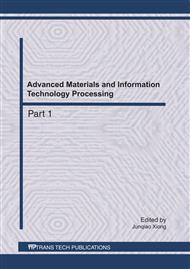[1]
Bustos, B., Keim, D., and Saupe, D., (2005), Feature-based similarity search in 3D object databases, ACM Computing Surveys, Vol. 37, New York, pp.345-387.
DOI: 10.1145/1118890.1118893
Google Scholar
[2]
Bustos, B., Keim, D., and Saupe, D., (2007), Content-Based 3D Object Retrieval, IEEE Computer Graphics and Applications, vol. 27- 4, pp.22-27.
DOI: 10.1109/mcg.2007.80
Google Scholar
[3]
Bustos, B., Daniel A. K., and Saupe, D., (2006), An experimental effectiveness comparison of methods for 3D similarity search, Int. J. on Digital Libraries 6(1), pp.39-54.
DOI: 10.1007/s00799-005-0122-3
Google Scholar
[4]
R. H. J., Corney, J. R., Clark, and D. E. R., (2001), Part-Sourcing in a Global Market", In 2001 International Conference on eCommerce Engineering, IceCE 2001, Xi, an, P. R. China.
Google Scholar
[5]
Osada, R., Funkhouser, T., Chazelle, B., (2001), Matching 3D Models with Shape Distributions, Proceedings of the International Conference on Shape Modeling & Applications, Washington, p.154.
DOI: 10.1109/sma.2001.923386
Google Scholar
[6]
Ip, C. Y., Lapadat, D., and Sieger, L., (2002), Using shape distributions to compare solid models, Seventh ACM Symposium on Solid Modeling and Applications, SIGGRAPH, vol. 17-23, pp.273-280.
DOI: 10.1145/566282.566322
Google Scholar
[7]
Funkhouser, T., Kazhdan, M., and Shilane, P., (2004), Modeling by Example, ACM Transactions on Graphics, Vol. 23-3, Siggarph, pp.652-663.
DOI: 10.1145/1015706.1015775
Google Scholar
[8]
Heczko, M., Keim, D., and Saupe, D. (2002), Methods for similarity search on 3D databases, Datenbank-Spektrum, Vol. 2-2, German, p.54–63.
Google Scholar
[9]
Liu, Y.J., Li, H., and Li, Z., M., (2006), 3D U System Moments Descr iptor and its Fast Calculating Method, China academic journal electronic publishing house, Vol 23, pp.27-30.
Google Scholar
[10]
Makadia, A., Visontai, M., and Daniilidis, K., (2007), Harmonic Silhouette Matching for 3D Models, Modern Information Retrieval, Addison-Wesley, pp.1-4.
DOI: 10.1109/3dtv.2007.4379399
Google Scholar
[11]
Quan, L., Yang, Z., (2008), A survey of content based similarity measures for 3D models, Proceeding of the 38th international conference on computers and industrial engineering, Beijing, Vol. 3-14, PP2193-2202.
Google Scholar


